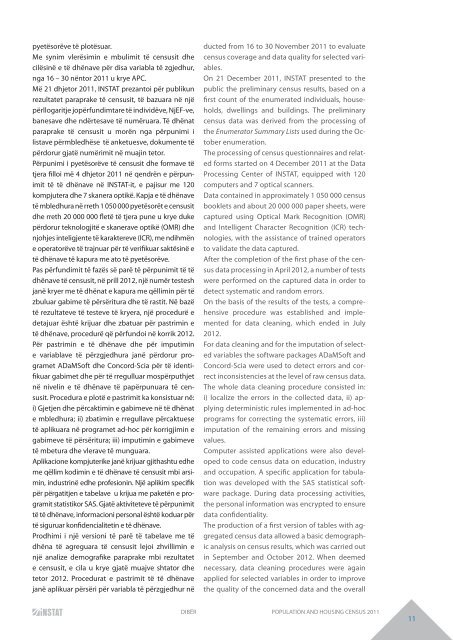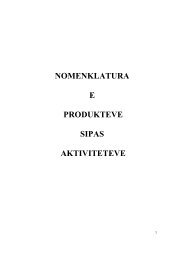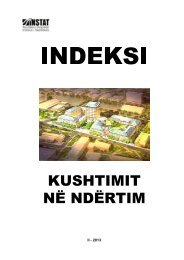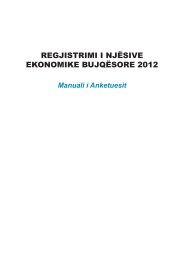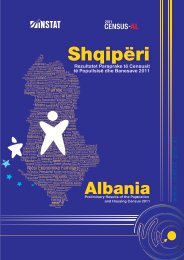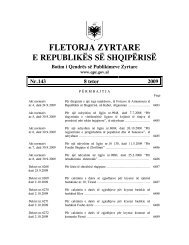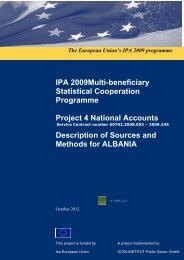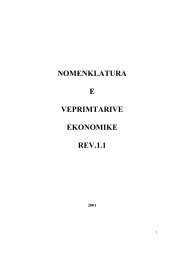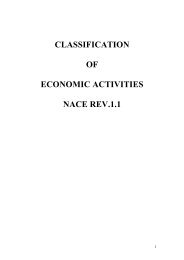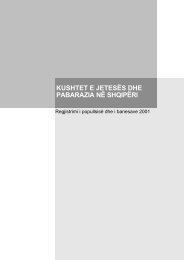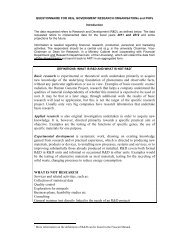DIBËR POPULATION AND HOUSING CENSUS 2011 - INSTAT
DIBËR POPULATION AND HOUSING CENSUS 2011 - INSTAT
DIBËR POPULATION AND HOUSING CENSUS 2011 - INSTAT
Create successful ePaper yourself
Turn your PDF publications into a flip-book with our unique Google optimized e-Paper software.
pyetësorëve të plotësuar.<br />
Me synim vlerësimin e mbulimit të censusit dhe<br />
cilësinë e të dhënave për disa variabla të zgjedhur,<br />
nga 16 – 30 nëntor <strong>2011</strong> u krye APC.<br />
Më 21 dhjetor <strong>2011</strong>, <strong>INSTAT</strong> prezantoi për publikun<br />
rezultatet paraprake të censusit, të bazuara në një<br />
përllogaritje jopërfundimtare të individëve, NjEF-ve,<br />
banesave dhe ndërtesave të numëruara. Të dhënat<br />
paraprake të censusit u morën nga përpunimi i<br />
listave përmbledhëse të anketuesve, dokumente të<br />
përdorur gjatë numërimit në muajin tetor.<br />
Përpunimi i pyetësorëve të censusit dhe formave të<br />
tjera filloi më 4 dhjetor <strong>2011</strong> në qendrën e përpunimit<br />
të të dhënave në <strong>INSTAT</strong>-it, e pajisur me 120<br />
kompjutera dhe 7 skanera optikë. Kapja e të dhënave<br />
të mbledhura në rreth 1 050 000 pyetësorët e censusit<br />
dhe rreth 20 000 000 fletë të tjera pune u krye duke<br />
përdorur teknologjitë e skanerave optikë (OMR) dhe<br />
njohjes inteligjente të karaktereve (ICR), me ndihmën<br />
e operatorëve të trajnuar për të verifikuar saktësinë e<br />
të dhënave të kapura me ato të pyetësorëve.<br />
Pas përfundimit të fazës së parë të përpunimit të të<br />
dhënave të censusit, në prill 2012, një numër testesh<br />
janë kryer me të dhënat e kapura me qëllimin për të<br />
zbuluar gabime të përsëritura dhe të rastit. Në bazë<br />
të rezultateve të testeve të kryera, një procedurë e<br />
detajuar është krijuar dhe zbatuar për pastrimin e<br />
të dhënave, procedurë që përfundoi në korrik 2012.<br />
Për pastrimin e të dhënave dhe për imputimin<br />
e variablave të përzgjedhura janë përdorur programet<br />
ADaMSoft dhe Concord-Scia për të identifikuar<br />
gabimet dhe për të rregulluar mospërputhjet<br />
në nivelin e të dhënave të papërpunuara të censusit.<br />
Procedura e plotë e pastrimit ka konsistuar në:<br />
i) Gjetjen dhe përcaktimin e gabimeve në të dhënat<br />
e mbledhura; ii) zbatimin e rregullave përcaktuese<br />
të aplikuara në programet ad-hoc për korrigjimin e<br />
gabimeve të përsëritura; iii) imputimin e gabimeve<br />
të mbetura dhe vlerave të munguara.<br />
Aplikacione kompjuterike janë krijuar gjithashtu edhe<br />
me qëllim kodimin e të dhënave të censusit mbi arsimin,<br />
industrinë edhe profesionin. Një aplikim specifik<br />
për përgatitjen e tabelave u krijua me paketën e programit<br />
statistikor SAS. Gjatë aktiviteteve të përpunimit<br />
të të dhënave, informacioni personal është koduar për<br />
të siguruar konfidencialitetin e të dhënave.<br />
Prodhimi i një versioni të parë të tabelave me të<br />
dhëna të agreguara të censusit lejoi zhvillimin e<br />
një analize demografike paraprake mbi rezultatet<br />
e censusit, e cila u krye gjatë muajve shtator dhe<br />
tetor 2012. Procedurat e pastrimit të të dhënave<br />
janë aplikuar përsëri për variabla të përzgjedhur në<br />
ducted from 16 to 30 November <strong>2011</strong> to evaluate<br />
census coverage and data quality for selected variables.<br />
On 21 December <strong>2011</strong>, <strong>INSTAT</strong> presented to the<br />
public the preliminary census results, based on a<br />
first count of the enumerated individuals, households,<br />
dwellings and buildings. The preliminary<br />
census data was derived from the processing of<br />
the Enumerator Summary Lists used during the October<br />
enumeration.<br />
The processing of census questionnaires and related<br />
forms started on 4 December <strong>2011</strong> at the Data<br />
Processing Center of <strong>INSTAT</strong>, equipped with 120<br />
computers and 7 optical scanners.<br />
Data contained in approximately 1 050 000 census<br />
booklets and about 20 000 000 paper sheets, were<br />
captured using Optical Mark Recognition (OMR)<br />
and Intelligent Character Recognition (ICR) technologies,<br />
with the assistance of trained operators<br />
to validate the data captured.<br />
After the completion of the first phase of the census<br />
data processing in April 2012, a number of tests<br />
were performed on the captured data in order to<br />
detect systematic and random errors.<br />
On the basis of the results of the tests, a comprehensive<br />
procedure was established and implemented<br />
for data cleaning, which ended in July<br />
2012.<br />
For data cleaning and for the imputation of selected<br />
variables the software packages ADaMSoft and<br />
Concord-Scia were used to detect errors and correct<br />
inconsistencies at the level of raw census data.<br />
The whole data cleaning procedure consisted in:<br />
i) localize the errors in the collected data, ii) applying<br />
deterministic rules implemented in ad-hoc<br />
programs for correcting the systematic errors, iii)<br />
imputation of the remaining errors and missing<br />
values.<br />
Computer assisted applications were also developed<br />
to code census data on education, industry<br />
and occupation. A specific application for tabulation<br />
was developed with the SAS statistical software<br />
package. During data processing activities,<br />
the personal information was encrypted to ensure<br />
data confidentiality.<br />
The production of a first version of tables with aggregated<br />
census data allowed a basic demographic<br />
analysis on census results, which was carried out<br />
in September and October 2012. When deemed<br />
necessary, data cleaning procedures were again<br />
applied for selected variables in order to improve<br />
the quality of the concerned data and the overall<br />
<strong>DIBËR</strong> <strong>POPULATION</strong> <strong>AND</strong> <strong>HOUSING</strong> <strong>CENSUS</strong> <strong>2011</strong><br />
11


